[wp_eStore_buy_now_fancy id=6]
For those of you that prefer PDFs to print, we now have a way for you to learn the secrets of the undead! For only $4.99, you can buy a PDF of Zombies of the World.

[wp_eStore_buy_now_fancy id=6]
For those of you that prefer PDFs to print, we now have a way for you to learn the secrets of the undead! For only $4.99, you can buy a PDF of Zombies of the World.
The books have arrived from Singapore! All the preorders have been mailed (except for Canada because of the strike). You can order your copy directly from this website or from Amazon if you don’t have Paypal. If you have a blog, podcast or magazine and would like to review Zombies of the World, please email zombie.studies@gmail.com to request a review copy. I want to give a specials thanks to all the preorder customers! You guys rock 😀
If you want to buy a copy in person, Zombies of the World will be available at Gencon Indy this year at the Arc Dream booth. I’ll be glad to autograph your copy. I also have a Zombies in gaming seminar at Gencon.
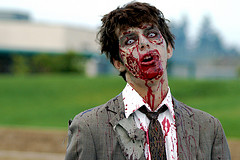 The Smithsonian Surprising Science blog has compiled a list of real zombie science links including mathematical modeling work to determine how fast zombies would infect a populace, zombie biology and other source of information. Sadly, these sources are rather rudimentary. Where is the work on zombies and renewable energy or speciation? As we have seen time and time again, zombies vary widely – some are fast, others are slow and others have exotic traits and abilities, yet no work is being done to explain the evolution of the zombie.
The Smithsonian Surprising Science blog has compiled a list of real zombie science links including mathematical modeling work to determine how fast zombies would infect a populace, zombie biology and other source of information. Sadly, these sources are rather rudimentary. Where is the work on zombies and renewable energy or speciation? As we have seen time and time again, zombies vary widely – some are fast, others are slow and others have exotic traits and abilities, yet no work is being done to explain the evolution of the zombie.
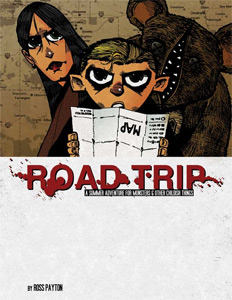 In order to create the book, I drew on the skills and resources I had gained while freelance writing in the tabletop RPG industry, running the podcast Role Playing Public Radio and designing books for Lens & Pen Press.
In order to create the book, I drew on the skills and resources I had gained while freelance writing in the tabletop RPG industry, running the podcast Role Playing Public Radio and designing books for Lens & Pen Press.
Writing: I’ve written two books for Arc Dream (Road Trip and Curriculum of Conspiracy) along with numerous shorter articles and PDFs for various companies. I’ve also written four long form PDFs for the New World Campaign, an original fantasy setting that I used for the RPPR Dungeons and Dragons campaign.
Writing for role playing games is an interesting combination of fiction and technical writing. You must write imaginative material that engages the reader yet it must described in a clear and concise manner so that it can be used in a complex game. Failing in the former task results in a boring piece that no one will want to use in their game and failing in the latter task results in rules arguments that derail the game. This style lends itself to the fictional pseudo-guide genre, as typified by books like the Zombie Survival Guide. For Zombies of the World, I went for the authoritative style common in nature guides and history texts.
Graphic Design: My background in graphic design is more limited than my writing but no less important. I’ve laid out every book published by Lens & Pen Press. While I do have some formal training in writing, my graphic design skills are entirely self-taught so I have no illusions about being a true master in this field. However, since I had developed journeyman level skills, I didn’t have to hire someone else to lay Zombies of the World out or do the prepress work so Tien Wah Press could print it. It also made it easier to write the book since I could adjust the layout to fit the content or vice versa. If a caption was a bit too long or short, it’s far easier to simply tweak it in Indesign than getting someone else to revise it.
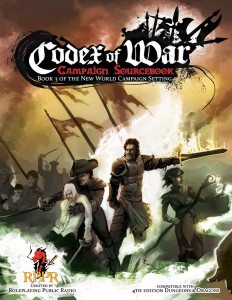 Collaborating over the Internet: Finding and working with artists from around the world you’ve never met face to face to create high end may sound like a daunting task if you’ve never done it before but I gained experience in doing this while working on Role Playing Public Radio. Starting in 2009, I collaborated with several artists and writers to create a series of book length PDFs for the RPPR actual play campaign, The New World. I wrote about the process of creating the first PDF, the New World Primer on my blog.
Collaborating over the Internet: Finding and working with artists from around the world you’ve never met face to face to create high end may sound like a daunting task if you’ve never done it before but I gained experience in doing this while working on Role Playing Public Radio. Starting in 2009, I collaborated with several artists and writers to create a series of book length PDFs for the RPPR actual play campaign, The New World. I wrote about the process of creating the first PDF, the New World Primer on my blog.
Through this, I met several great artists and how to contact other artists about collaborating on the Internet. Talking with them consisted mostly of emails and IMs to determine how much they could contribute, what they would contribute and other technical issues. The greatest challenge comes from communicating the ideas you want the artist to draw without confusing or alienating them. It’s also preferable, in my experience, to encourage the artist to make suggestions about the piece. They often have great ideas on improving the quality of the art. In general, I would describe the work I needed in a few paragraphs and then provide relevant background information and reference work for the artist. Then the artist would create a sketch and make suggestions and we would go back and forth until the piece had been hashed out. There’s a fine line between being too demanding and exacting and being too vague. It’s important to strike a balance between them so the artist doesn’t get burned out or confused.
With these skills, I was able to create Zombies of the World. In the next post, I’ll talk about planning and design and its importance in creating the book.
 Zombies of the World will be displayed at the Book Expo of America and as part of that, there is a flash preview available of the book online, available here. You can only see up to 20 pages but you can skip around to see the different sections of the book.
Zombies of the World will be displayed at the Book Expo of America and as part of that, there is a flash preview available of the book online, available here. You can only see up to 20 pages but you can skip around to see the different sections of the book.
 Making a good short film with very little money is difficult but it rewards creative thinking. More importantly, by knowing your limitations, it’s possible to write a story that seems to have a higher budget than it actually does. This is a long standing tradition for independent film and video production. Robert Rodriguez got a lot of mileage for his first film, El Mariachi by creatively using what limited resources he had available to him. For Zombies of the World, I had to keep a few limitations in mind:
Making a good short film with very little money is difficult but it rewards creative thinking. More importantly, by knowing your limitations, it’s possible to write a story that seems to have a higher budget than it actually does. This is a long standing tradition for independent film and video production. Robert Rodriguez got a lot of mileage for his first film, El Mariachi by creatively using what limited resources he had available to him. For Zombies of the World, I had to keep a few limitations in mind:
 Production was thankfully fairly uneventful. We shot on three separate days – one for each location. The shortest day was the warehouse where a Chinese Hopping Corpse attacks a worker while the longest was at the Creamery Art Center. We shot the interviews, the mummy sign language scenes in the main floor and the Aztec Mummy vs. Robot fight in the center’s basement.
Production was thankfully fairly uneventful. We shot on three separate days – one for each location. The shortest day was the warehouse where a Chinese Hopping Corpse attacks a worker while the longest was at the Creamery Art Center. We shot the interviews, the mummy sign language scenes in the main floor and the Aztec Mummy vs. Robot fight in the center’s basement.
The inclusion of robots into Zombies of the World was necessary so I could include a reference to the classic Mexican horror film The Robot vs. The Aztec Mummy. I looked into the copyright status of the film in order to see if I include a clip into the web series. Sadly, it is not public domain so I could not use real footage, thus the recreation. Another reason I wrote the fight scene in the script was because I knew I had access to the Center’s basement, which is appropriately creepy, especially with the right lighting and visual effects. You’ll see the videos online in the next month.
 In order to realize the documentary style, I commissioned Tom Rhodes and Bryant Koshu to create ‘artist’s recreations’ of key concepts in the series. These images would be panned across, like a Ken Burns’ documentary. After the production finished, I realized I had more ideas than I began with and I had a lot of great art from the series. With my background in writing and graphic design, I could create a book about zombies.
In order to realize the documentary style, I commissioned Tom Rhodes and Bryant Koshu to create ‘artist’s recreations’ of key concepts in the series. These images would be panned across, like a Ken Burns’ documentary. After the production finished, I realized I had more ideas than I began with and I had a lot of great art from the series. With my background in writing and graphic design, I could create a book about zombies.
In the next post, I’ll talk about the process of writing Zombies of the World.
An idea for a story is not the same as an actual story. Stories need a form, a medium. These ideas of reversing and exploring common zombie tropes could be made into several types of stories, but picking the right one was a long process. Zombie stories are often told through film, novels or video games. Feature length movies still seem to dominate independent productions, especially zombie genre stories.
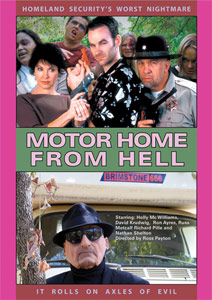 My previous experience in making a feature length film, Motor Home from Hell, dissuaded me from trying again. While making the movie was a challenging and interesting experience, trying to market and distribute it was even harder. It takes an entirely different skill set to sell a movie than it is to make one. Sinking that much time and money into a feature length Zombies of the World movie without having a solid plan to sell it wasn’t appealing.
My previous experience in making a feature length film, Motor Home from Hell, dissuaded me from trying again. While making the movie was a challenging and interesting experience, trying to market and distribute it was even harder. It takes an entirely different skill set to sell a movie than it is to make one. Sinking that much time and money into a feature length Zombies of the World movie without having a solid plan to sell it wasn’t appealing.
Novels were far cheaper to produce than movies but my ideas were more suited for world building than a single narrative. I was more interested in describing a world with different rules for the undead than a single character’s life. Plus, the novel market is flooded and in turmoil. Traditional publishing companies are struggling to adapt as they can’t support successful midlist writers anymore. Video games are even more resource intensive than movies to make and I personally didn’t have any of the primary skills to make them – programming or artistic ability.
So, the first iteration of Zombies of the World was not a written text but a web video series. Unlike movies, a web video can provide immediate feedback and engagement. Most people think of memes such as Rebecca Black’s Friday but I was more inspired by the new wave of serials like Marble Hornets or The Guild. They developed dedicated fanbases that follow their work and tell their friends about it. Plus, as a new form, the rules and conventions are not firmly established. I wanted to focus on each idea without having to worry about writing episodes to a given length or story arc.
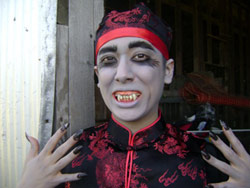 I outlined and wrote a zombie mockumentary thematically based around cable TV nature shows, like the type you would see on the Discovery Channel or Animal Planet. Each episode would be short and to the point, focusing on a topic such as migration or adaptation.
I outlined and wrote a zombie mockumentary thematically based around cable TV nature shows, like the type you would see on the Discovery Channel or Animal Planet. Each episode would be short and to the point, focusing on a topic such as migration or adaptation.
Zombies of the World first began with a single observation about zombies – they never get tired. To me, that seemed more interesting than their resurrection or predilection for human flesh. Even the few zombies that manage to catch and eat a human never seem to digest the meat and true zombies never starve. They continue to burn energy without taking in fuel. This defies the laws of thermodynamics and makes the zombie a flesh eating perpetual motion machine. With that, I began to think of how that would affect the world so I could tell my own zombie story. The genre is dominated by survivalist themed works that can be fun or even great but I wanted to do something different with them.
While zombie apocalypses are fun for storytelling and gaming purposes, they tend to follow several rules:
With that in mind, I wanted to break these rules so I could see how a stable society would treat the undead. So you would get:
There have been a few stories set in worlds where humanity and zombies have learned to co-exist but they tend to be post-apocalyptic – societies that rebuild after the zombies nearly wipe everything out. By breaking all of these rules, you get a world that has had to deal with the undead for thousands of years but has learned how to deal with them.
Furthermore, wouldn’t the scientists of that world study them and try to learn how they remain animate after death? So, I pictured a world much like our own. Zombies were contained by government agencies. Some species were endangered or even extinct. Scientists and environmentalists lobbied for laws to protect the undead, because they were part of the ecosystem and needed to be studied. That is how Zombies of the World began.